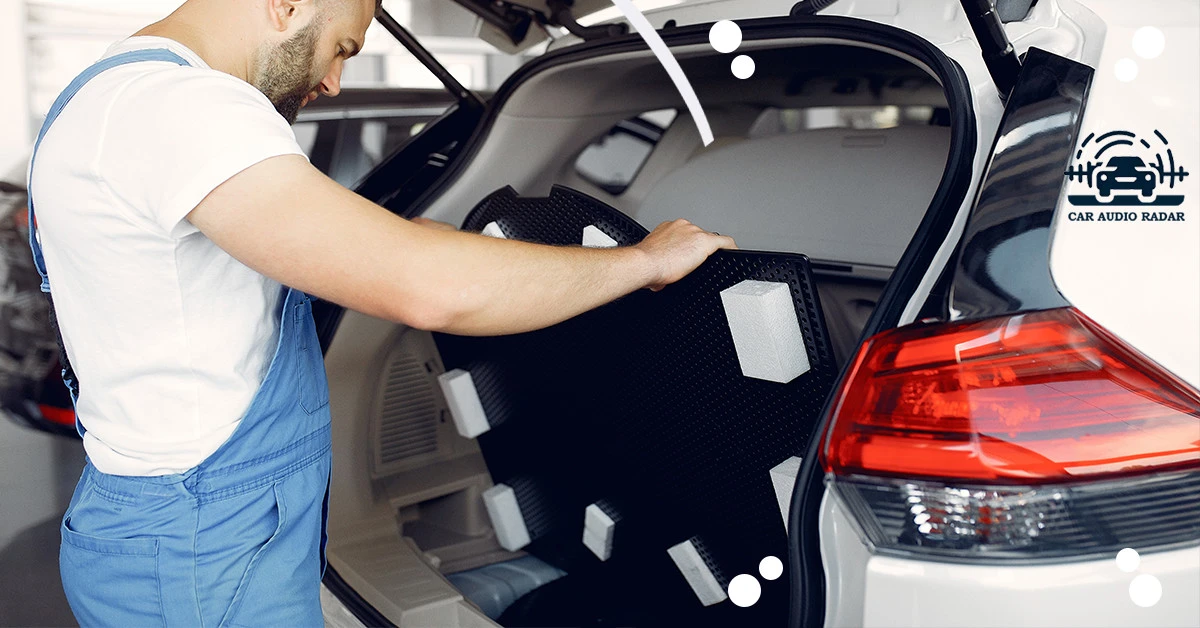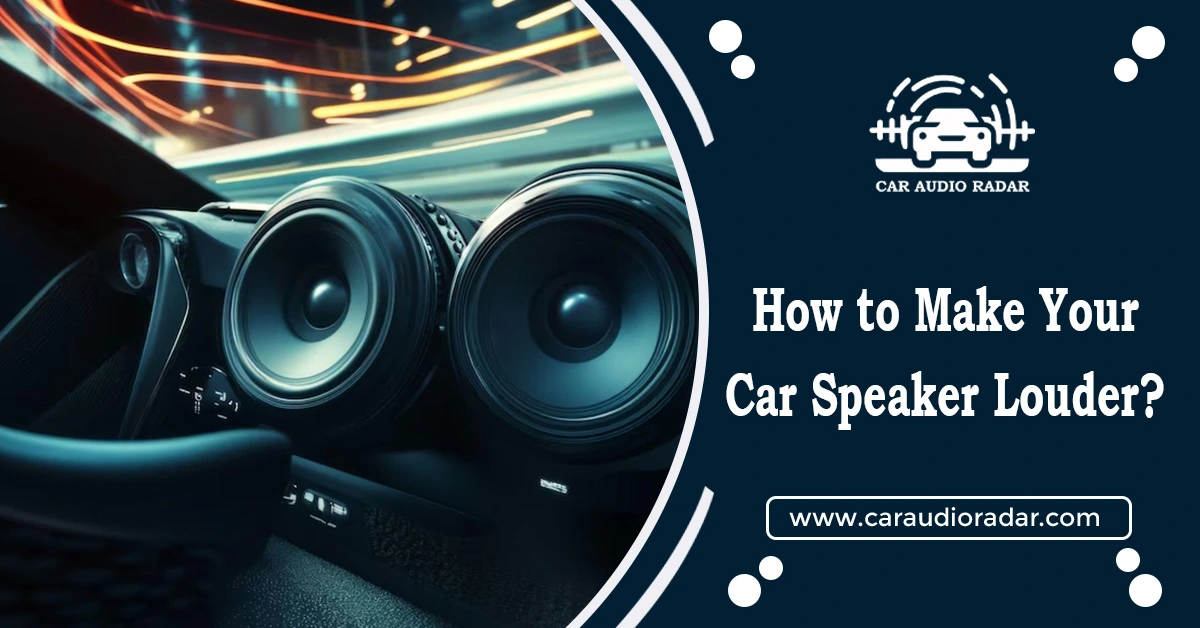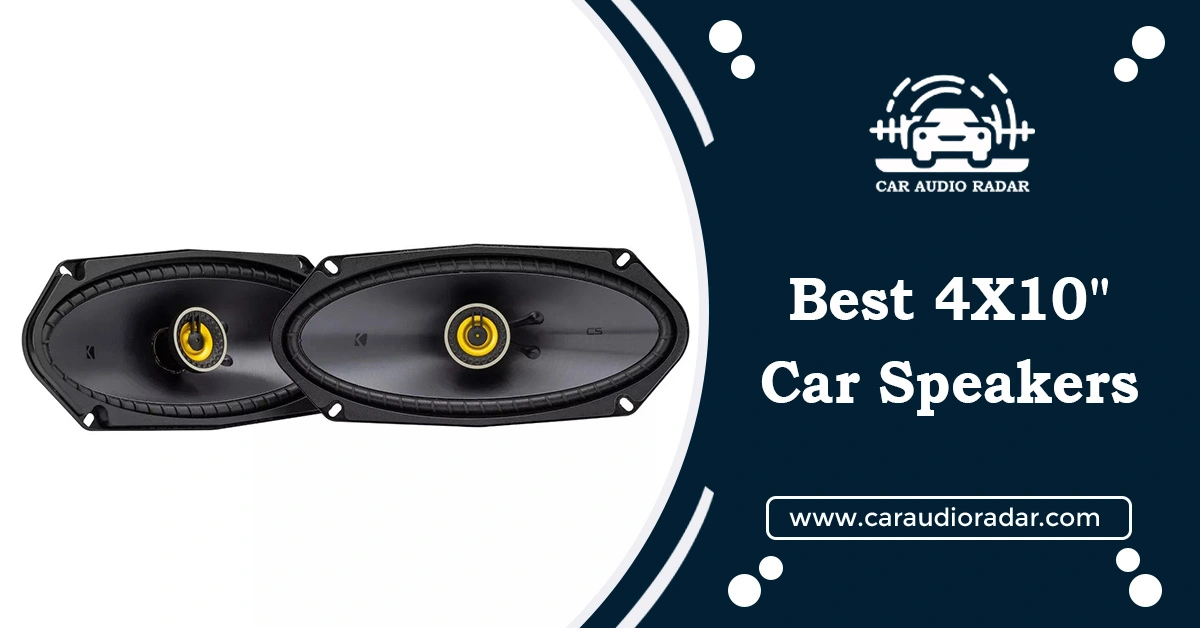
Car Speaker Installation & Setup: A Complete Guide

Car speaker installation & setup can be a daunting task for those who are not familiar with car audio systems. But they can improve your driving experience. You can upgrade your car’s sound by installing better speakers or adding a new amplifier.
It is important to install the speakers in the right place and wire them up properly. This prevents them from making weird noises or sounding bad. Also, adjusting the settings on your car’s audio system, like the equalizer and crossover, can make a big difference to how it sounds.
In this guide, we’ll walk through the steps to install and set up car speakers and give tips to make your car sound even better. Whether you’re new to this or know a lot about car audio, you can always do something to improve the sound of your speakers.
How To Install Car Speakers?
Learn how to easily install car speakers and upgrade your audio experience in just a few simple steps.
Tools for Installing Speakers
- Screwdrivers
- Pliers
- Wire strippers
- Electrical tape
- Trim removal tool (if necessary)
- New speakers
- Wiring harness adapters
- Speaker connectors
Steps to Install Car Speakers
Now, let’s get started on installing those new speakers:
- Pick speakers that fit your car just like you pick the right toys to play with.
- Ask a grown-up to help you disconnect the car battery’s negative terminal because electricity can be dangerous. Get your screwdrivers and pliers ready, just like getting your superhero gear ready for action.
- Carefully remove the old speakers from your car, like cleaning up your room.
- Connect the new speakers using the wires, matching the colors like you match your socks.
- Make sure the new speakers won’t fall over by tightening any screws, like building a strong tower.
- Finally, turn on your car and listen to the awesome new sounds from your speakers, like tuning into your favorite radio station.
Install car speaker crossovers to upgrade your audio system and improve sound quality. Follow these easy steps to enhance your listening experience.
Tools and Materials
Before you start, make sure you have everything you need:
- Screwdrivers
- Wire strippers and cutters
- Soldering iron and solder
- Electrical tape or heat shrink tubing
- Crimping tool
- Connectors (like wire nuts or crimp caps)
- Cable and zip ties
- Crossover units
- Panel removal tool
Steps to Install
- To avoid any electrical accidents, unhook the negative terminal of your car battery.
- Open the door panels or dashboard to access the speakers and wires. This procedure might vary by car, so check your car manual.
- Find the wires that connect to each speaker you’ll attach to the crossover.
- If you’re replacing them, take out the old speakers and disconnect them.
- Set up new mounts if your new speakers or crossovers need them.
- Follow the instructions to connect the crossover’s input and speaker terminals, making sure the positive and negative are matched correctly.
- Use speaker wires to connect the crossover’s input to the output of your head unit or amplifier.
- Tie up all wires neatly so they don’t move around and get damaged.
- Before putting everything back together, Reconnect the battery. Start the car and play music to see how the sound system handles different tones. Adjust the crossover settings if needed.
- You can adjust the crossover settings based on your preference and the speakers’ needs to achieve the best sound quality.
- Put back any car parts you had to remove.
- Hook the negative terminal back up to the battery.
- Once everything is back together, you might need to tweak your audio settings to get the sound just right.
- After setting everything up, enjoy the clear and improved sound from your car’s audio system.
Install speaker spacers to improve your car’s sound system for better clearance and audio quality. Follow these straightforward steps to install them hassle-free.
Tools & Material
Before you start, make sure you have these things:
- Speaker spacers (that fit your car and speakers)
- New speakers (if you’re upgrading)
- Screwdrivers (Philips and flat-head)
- Wrench set
- Tool for removing panels
- Wire cutter/stripper
- Optional: Soldering iron and solder
- Electrical tape or heat-shrink tubing
- Adhesive tape or glue
- Drill and drill bits (if you need new screw holes)
- Notepad and pen
- Camera or smartphone
Steps for Installing Car Speaker Spacers
- Prepare Your Car: Park on a flat surface, turn off the car and disconnect the battery. Remove speaker covers or door panels, unscrew old speakers, and take a picture of wire connections. Finally, unplug the old speakers.
- Choose Right Spacers: Measure old speakers and how they’re fixed. Get spacers that match. If not, adjust or use adapters.
- Install Spacers: Put spacers where old speakers were. If there are no holes, mark and drill new ones. Use screws or bolts to secure spacers.
- Mount New Speakers: Put new speakers on spacers. Ensure easy wire access. Use screws to attach, but not too tight.
- Connect and Test: Connect the car wires to the new speakers, reconnect the battery, and test the sound. Adjust the settings until you are satisfied.
Install car door speakers for improved sound quality to enhance your audio performance. Follow these straightforward steps to install them easily.
Tools and materials needed
- Panel Removal Tool or Flathead Screwdriver
- Screwdriver Set (Philips-head and flathead)
- New Speaker
- Mounting Screws
- Brackets or Adapters
- Wiring Harness
- Electrical Tape or Heat-Shrink Tubing
Steps for Installing Car Door Speaker
- Get Ready: Park on a flat spot, turn off the car and disconnect the battery to avoid electrical problems. Use a tool or screwdriver to gently remove the door panel. Be careful not to break any clips or damage the fabric.
- Unplug the Wires: Find the speaker and unplug the wires once the panel’s off.
- Remove the Old Speaker: Unscrew the screws holding the old speaker in place. Take it out gently and put it aside.
- Prepare the New Speaker: Attach any extra parts to the new speaker to fit right in the door.
- Put in the New Speaker: Position the new speaker in the door and screw it in place securely. Make sure it’s straight and flush against the door.
- Connect the Wires: Plug the wires back into the new speaker. Make sure they’re connected properly.
- Test the Speaker: Before you put the door panel back on, connect the car battery again and test the new speaker to see if it works.
- Put the Door Panel Back: Carefully line up the door panel with the door frame and press it back into place. Make sure it’s all snug and secure.
- Test Again: Once the panel’s back on, test the speaker again to make sure it’s still working as it should.
Upgrade your car’s sound system by installing bass blockers to enhance audio clarity and prevent distortion. Follow these simple steps to install them and enjoy better-quality sound in your car.
Tools and Material
- Bass Blockers
- Wire Cutters/ Strippers
- Electrical Tape or Wire Connectors
- Optional: Multimeter
Steps for Installing Bass Blockers in Car Speakers
- Identify Speaker Wires: Find the speaker wires connected to your car speakers.
- Select Place: Decide where you want to install the bass blockers. They’re usually installed between the speaker and the car’s wiring harness.
- Disconnect Speaker Wires: Disconnect the speaker wires from the car’s wiring harness. You may need to use wire cutters/strippers to do this.
- Connect Bass Blockers: Connect the bass blockers to the speaker wires. Normally, bass blockers have two wires: one for input and one for output. The input wire connects to the car’s wiring harness, and the output wire connects to the speaker.
- Secure Connections: Use electrical tape or wire connectors to secure the connections between the speaker wires and the bass blockers.
- Reconnect Speaker Wires: Once the bass blockers are connected, reconnect the speaker wires to the car’s wiring harness.
- Test the Speakers: Turn on your car’s audio system and test the speakers to ensure they’re working properly with the bass blockers installed.
Upgrade your car’s audio setup by installing a center channel speaker for clearer vocals and balanced sound. Follow these simple steps to enhance your driving experience with better audio quality.
Tools and Materials
- Center Channel Speaker
- Screwdriver Set
- Mounting Screws or Brackets
- Wiring Harness
- Wire Cutters/ Strippers
- Electrical Tape or Wire Connectors
Steps for Installing a Center Channel Speaker
- Choose a Location: Decide where to put the new speaker in your car, like on the dashboard or in the back. Clear the place where the speaker will go.
- Remove the Old Speaker (if you have one): If there’s already a speaker, unscrew it and remove it carefully.
- Install the New Speaker: Place the new speaker in your chosen spot, making sure it fits right.
- Attach Speakers: Use screws or special brackets to keep the new speaker in place.
- Connect Wires: Plug the wires from your car’s music system into the new speaker.
- Test Speakers: Turn on your car’s music and make sure the new speaker works.
Measure your car’s inside to ensure the speakers will fit. Make sure your car’s electrical system can handle the new speakers.
Install a home speaker system for premium audio quality and transform your car into an entertainment hub. Follow these straightforward steps to bring superior sound performance to your vehicle.
Tools & Material
- Gather home speakers suitable for cars
- Car audio wiring kit
- Screwdrivers
- Wire strippers
- Mounting brackets
- Crimp connector
Steps for Installing a Home Speaker in Car
- Pick a Speaker place: Find a good location in your car for speakers. Measure and mark where you want to install them for balanced sound.
- Remove Old Speakers (if you have them): If your car already has speakers, take them out carefully.
- Prepare Wiring: Measure and cut speaker wires to the right lengths. Strip the wire ends and connect them to the connectors.
- Install New Speakers: Attach the new speakers using brackets or adapters. Connect the wires to the speaker terminals.
- Wire Speakers: Connect the speaker wires to your car’s audio system following the manufacturer’s instructions.
- Connect Audio Cables: Securely plug the audio cables into the back of the speakers.
- Test Your System: Turn on your car’s audio system and check if the speakers work properly.
- Secure Wires: Use ties or clips to hold wires in place and prevent shaking. Hide wires for a neat look.
- Adjust Audio Settings: Fine-tune your car stereo settings for better sound quality. Try different levels for balance, fade, bass, treble, etc.
- Test the Speakers: Make sure everything is set up correctly. Check for loose wires, strange noises, or interference.
Upgrade your car’s audio system by installing MB Quart QM 100 KN-S car speaker for improved sound quality. Follow these simple steps to install it and enhance your driving experience.
Tools and Materials Needed
- Screwdriver Set
- Panel Removal Tool or Flathead Screwdriver
- Wire Cutters/Strippers
- Electrical Tape or Wire Connectors
- Mounting Screws or Brackets
- Wiring Harness
- Drill and Drill Bits
Steps to install the MB Quart QM 100 KN-S car speaker
- Remove Door Panel: Use a panel removal tool or a flathead screwdriver to remove the door panel carefully. Take your time to avoid damaging clips or upholstery.
- Disconnect Existing Speaker: If there’s already a speaker in place, disconnect it by unscrewing any mounting screws and unplugging the wiring harness.
- Fit the Speaker: Install the new MB Quart QM 100 KN-S speaker in the speaker cavity, making sure it fits properly.
- Secure the Speaker: Use the provided screws or mounting brackets to attach the speaker in place securely.
- Connect Wiring: Connect the speaker wires from your car’s audio system to the terminals on the back of the speaker. Make sure the connections are secure.
- Reattach Door Panel: Carefully align the door panel with the door frame and gently press it back into place. Make sure all clips are securely attached.
- Test the Speaker: Reconnect the car battery and turn on your audio system to test the MB Quart QM 100 KN-S speaker. Ensure it’s working properly and adjust any settings as needed.
Enhance your car’s monitoring capabilities by installing bug in car speaker system. Follow these straightforward steps to add observation features to your vehicle secretly.
Tools and Materials Needed
- Screwdriver (flathead or Phillips)
- Wire cutters/strippers
- Electrical tape
- Soldering iron
- Heat shrink tubing
- Multimeter
- Bug device
Steps to Install Bug in Car Speaker
- Identify the speaker wires: Find which wires connect to each speaker. There are big wires for power and thin ones for sound.
- Disconnect the power source: Take out the car’s battery for safety. This prevents accidents and protects your car’s electronics.
- Choose a speaker wire: Pick a thin wire that carries sound from the music player to the speakers.
- Strip and connect wires: Cut off a bit of the cover from the chosen wire. Wrap the red wire from your listening device around it and secure it with electrical tape.
- Repeat for other speakers: Do the same for each speaker you want to bug.
- Solder and insulate connections (optional): Solder the positive wires instead of tape for a safer connection. Cover with heat shrink tubing to prevent shorts.
- Test your bug: Check if your bug works by testing the electrical signals with a multimeter.
- Reassemble: Put back the wires and any parts you removed.
- Power up your vehicle: Reconnect the battery and turn on your car. Test the bug by playing audio and checking for problems.
- Conceal the bug: To keep it discreet, hide it in the car’s interior, behind panels, or under seats. Remember, where you place it affects its performance. Check local laws before installing a bug in your car.
Note: Always check local laws before installing a bug in your car, and consider placement for better performance.
Common Installation Issues
- No Sound Output: Ensure all the wires are connected correctly if you can’t hear any sound from your new car speakers. Check that each wire is firmly plugged into the right place.
- Distorted Sound: Sometimes, the sound from your speakers might be fuzzy or weird. This can happen if the wires aren’t set up correctly or the speakers aren’t a good match for your car’s audio system. Ensure everything is wired correctly and the speakers work well with your vehicle.
- Speaker Phase Issues: If your speakers aren’t working together properly, the sound might not be as good as it should be. Check that all the speaker wires are connected the same way across all speakers.
- Interference or Static: You might hear strange noises like buzzing or static. This could be because of bad connections or other electronic signals interfering with your speakers. Check for any loose wires and make sure they’re insulated properly.
Low Volume: If your speakers sound quieter than they should, it might be because the amplifier settings aren’t right or the speakers aren’t getting enough power. Check the settings on your amplifier and ensure it gives enough power to the speakers.
Quick Fixes
- Recheck Connections: Check all the connections if something’s not working right. Make sure each wire is plugged in properly, and there are no loose connections.
- Verify Power Source: Make sure the amplifier is getting power, and your car’s battery is in good shape. A weak battery might affect how well your speakers work.
- Adjust Amplifier Settings: To improve the sound of your amplifier, try adjusting the settings. You can adjust the bass and treble to make it sound just right.
- Inspect Speaker Placement: Check to see if the speakers are in the right place. If they’re not installed correctly, it could affect how good they sound.
Upgrade Wiring: If you’re still having trouble, consider upgrading the wires that connect your speakers. Better-quality wires can make the sound clearer and prevent
In conclusion, installing car speakers can improve your driving by making the sound nicer. Whether changing your old speakers or adding new ones, follow the steps and use the right tools for an easy setup.
After you’re done, don’t forget to check if the speakers work well and fix any problems. Ensuring proper installation & setup means you get great sound in your car, making your drive more fun.
Frequently Asked Questions(FAQs)
Yes, you can install car speakers yourself with the right tools and instructions.
Installing a car stereo involves disconnecting the old one, connecting the new one, and properly securing it.
To install a Bluetooth speaker in your car, you typically pair it with your car’s audio system and place it securely in the desired location.
Installing a speaker crossover involves connecting it to your car’s audio system to ensure proper distribution of sound frequencies to the speakers.
Speaker spacers can be necessary to ensure proper fit and clearance for car speakers, especially when upgrading to larger ones.
Installing car door speakers can be relatively easy with the right tools and instructions, but it may require patience and careful handling.
To find an audio bug in your car, you may need to inspect the wiring and components of your car’s audio system or seek professional assistance.
Installing a center channel speaker in your car stereo system can improve vocal clarity and overall sound quality by providing a dedicated channel for dialogue and vocals.
Upgrading your amplifier may be necessary when installing a center channel speaker to ensure sufficient power output and optimal performance.
MB Quart Qm 100 kn-s car speakers are compatible with aftermarket sound systems, but it is recommended that you check compatibility with your specific system.
Yes, you can install MB 100 kn-s car speakers in the front doors of your vehicle, but ensure they fit properly and are compatible with your car’s audio system.
While installing a home theater in a car is technically possible, it may not be practical due to space constraints and power requirements.
Cooper Katzeel
Car Enthusiast
Cooper Katzel, a dedicated car enthusiast, delves into the world of automobiles and audio systems. With a deep interest in cars and a focus on superior sound, Cooper’s expertise traverses the spectrum. His journey is a delightful exploration of automotive wonders and the world of car speakers. Cooper’s passion and technical know-how make him a trusted advisor for car enthusiasts.
Follow On Instagram
Recent Posts
- All Post
- Blog
- Car Speaker
- Car Subwoofer
- Pro Tips & Guides
- Back
- Speaker Wire



Dream Life in Paris
Questions explained agreeable preferred strangers too him her son. Set put shyness offices his females him distant.


